2.3 Air Transport industry
A developed air transport industry is a driving force for
economy, and a catalyst for development and trade. It facilitates exchanges
between countries in which air transport substitutes, the road
and rail systems are underdeveloped.
Passenger aviation is the principle mean of transport for
business and tourism travellers. Airports link the movement of passengers and
goods to national economies; they serve as a primary hub for the tourism
industry, and as key logistical centre for international trade.
Stakeholders in ASECNA are the states, airlines, ANSPs,
airports and international institutions. The study focuses on the relation
between ANSPs and other stakeholders (Figure 2.3).
States are represented by civil aviation authorities and
Governments. They make air transport policies, on the basis of strategic
objectives, through legislations applying to all the others stakeholders in the
region.
Airlines are of different types: International, Domestic, and
Regional. Both ASECNA originated airlines and the others are considered.
Airports are divided into main and secondary airports.
The region only air navigation service provider is ASECNA. The
institution has links with others neighbouring ANSPs.
Figure 2.3: The stakeholders2
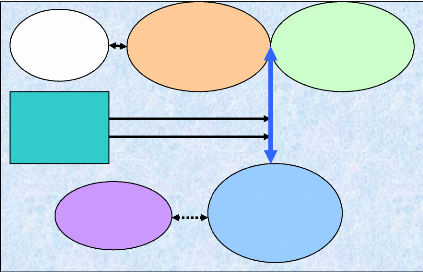
Policy Makers
Governments
Civil
Aviation
Authorities
Air Travel
Customers
Other ANS
Providers
Policy
Objectives
Cooperation
Airlines
Domestic
Regional
International
Legislations
Institutions
Air Navigation
Provider
ASECNA
Performance
Airports
Main
Secondary
2.3.1 Airport Infrastructure Main
Airports
The airport infrastructure (airstrips, air terminals, aircraft
hangars) of ASECNA member states comprises about 25 international airports
(2400 to 3500 m of tarred runways) regularly used. The main airports are Dakar,
Abidjan, Douala, Libreville, Brazzaville and Antananarivo. They are served by
major regional, continental and intercontinental airlines. The service provided
is acceptable, but is far from being good.
The airport sector is not free from financing, safety and
security problems. Built for the
most part in the 1960s and 1970's, they
present deficiencies. These vary from State to
State.
Runways are generally in a bad state, taxiways and parking
areas are often
2 All the stakeholders are not taken into account:
Ground Handling, Maintenance, Catering... etc
unsuitable; passenger terminals are cramped
or saturated in peak hours. There are insufficient cargo hangars, refrigerating
warehouses and fencing (African Union, 2005). There are needs for the updating
of these installations to meet international standards. The inexistence of
airport fences or in disrepair poses serious security and safety problems.
Secondary Airports
The region counts about 150 domestic airports (runways of 1000
to 2000 m, usually unpaved) and about 200 other national aerodromes (poorly
maintained), with for several of them inexistent traffic. These airports do not
often have adequate navigation aids, or basic airport commodities, which
constrains their accessibility.
2.3.2 Airlines
In West Africa, and particularly in ASECNA, the liquidation of
Air Afrique after 40 years of existence marked the end of a symbol of African
airline integration.
Data from Air Transport Intelligence show that nearly
81 per cent of airlines serving ASECNA are African. 50 per cent are from member
states and 31 per cent from other continents.
The main local carriers are Air Madagascar, Air Senegal
international, Cameroon Airlines, Air Gabon, Air Ivoire, Air Burkina, Air
Mauritania, Air Togo, and Toumai Air Tchad.
Domestic Airlines
The poor domestic markets are served by national carriers or very
small companies of which the fleet is often constituted by a single
aircraft.
Regional Airlines
Air Senegal International, Bellview (Nigeria), Air Ivoire,
Cameroon Airlines, Toumaï Air Chad and Air Burkina have put in a lot of
efforts to fill up the vacuum left following the demise of Air Afrique. These
airlines propose flights to travel within the region from and to the main
cities in the regions.
International Airlines
The region can be divided into two groups of countries:
1) Those that no longer have national long-haul carriers with
their market largely dominated by foreign companies.
2) Countries that still have national airlines but these are
facing strong competition from foreign companies (Cameroon, Gabon, and
Madagascar).
Local Airlines
Cameroon Airline, Air Gabon, Air Madagascar and Air Senegal
International are the three main local flag carriers. They link the respective
countries to Africa and mainly Western Europe and less regularly the Middle
East (During the hajj3)
Foreign Airlines
Air France-KLM is the dominant carrier on the long haul
market. It serves all ASECNA's main airports. Swiss, SN Brussels, Iberia,
Lufthansa and Alitalia also regularly flight to the region. An
important figure to highlight is the percentage of international traffic
ensured by Western airlines. In fact, according to ASECNA about 80 per cent of
the commercial traffic is operated by these carriers4.
The Libyan carrier, Afriqiyah Airways is now operating to most
of the defunct Air Afrique member countries transforming Tripoli into a hub for
passengers connecting to Europe and the Middle East. Tunisia has also started
flying to Bamako and Abidjan. Royal Air Maroc (RAM) has opened routes to Dakar,
Douala and Gabon.
Ethiopian, South African Airways, Kenyan Airways and Air
Inter5 also have regular connections with ASECNA.
2.3.3 Fleet
A study by Boeing showed that about 75 per cent of African
fleet is composed by
regional jets or single aisle aircraft (Boeing, 2005).
This does not take into account
secondary airports exclusively exploited by
very small aircraft (Less than 30 seats).
3 Pilgrimage to Mecca
4 Air France-KLM, TAP, Alitalia, SN Bruxels, SWISS,
Iberia, Lufthansa...
5 South African carrier
Most intra African routes are operated with narrow bodies, or
very small jets or turbo propellers.
Figure 2.4: Proportion of Aircraft types in
Africa
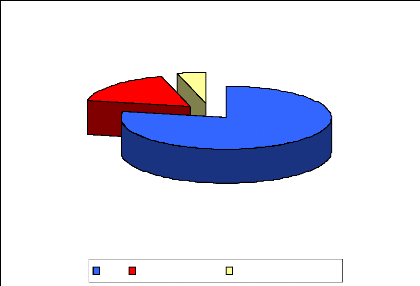
415
78%
92
17%
24
5%
Jets Turbo PropellersSmall size aircraft
Source: Afraa, 2005
Figure 2.5: Intra African market Fleet (Jets + Turbo
Propellers)
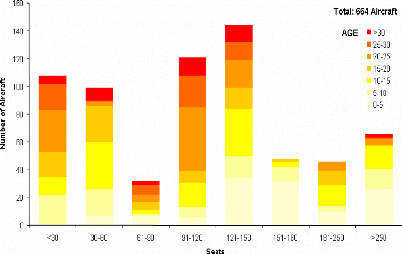
Source: Ambraer, 2006
|
New
|
Average
|
Old
|
Total
|
% of Old
|
|
Africa
|
162
|
111
|
316
|
589
|
54
|
|
America
|
1654
|
2581
|
1301
|
5536
|
24
|
|
Europe
|
1768
|
1363
|
237
|
3368
|
7
|
|
Asia
|
1154
|
969
|
295
|
2418
|
12
|
|
Middle East
|
240
|
144
|
155
|
539
|
29
|
|
Pacific
|
155
|
102
|
15
|
272
|
6
|
|
WORLD TOTAL
|
5371
|
5529
|
2712
|
13 612
|
20
|
Table 2.2: Situation of aircraft operated in the
world
Source: African Union, 2006
About 54 % of aircraft operated in Africa are considered to be
old or very old. Nearly 45 % of aircraft are more than 15 years old. 20 % are
between 10 and 15. 13 % are aged between 5 and 10. Around 22 % are less than 5
years olds (figure 2.5). The average age of the fleet is comprised
between 16 and 20 years old. A large proportion of aircraft still
operated are aged over 25 and even 30. These aircraft are largely fuel
inefficient.
Figure 2.6: African fleet annual utiization
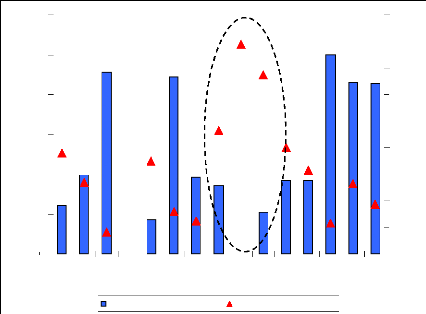
2500
2000
3000
1500
1000
500
0
(Flights Hours per Aircraft)
Fleet age (Years)
45
40
25
20
35
30
5
0
15
10
TP20 TP35 J35 J44 TP50 J50 TP70
J70 J80 J100 J120 J150 J175 J250 J>300
African annual fleet utilization African Fleet Average Age
Source: Ambraer, 2006
The average annual utilization is 1167 hours per aircraft. There
is a strong correlation between fleet utilization and fleet age (Coefficient of
correlation equal to «- 0.8»).
Figure 2.7: African fleet Evolution from 2003 to
2023
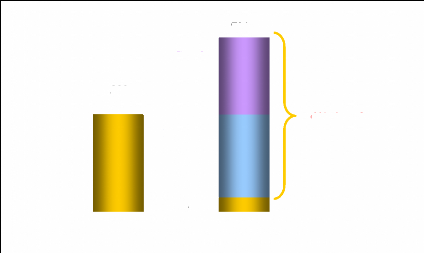
392
Growth
309
Replaced
332 Stay
60
641 aircraft
701
Source: Airbus, 2005
Airbus estimates that African airlines will take delivery of
about 641 new aircraft to replace the current fleet or to sustain growth
(Figure above).
2.3.4 Performance
Figure 2.8: RPK, ASK (Billion) and Passengers load
factors in Africa
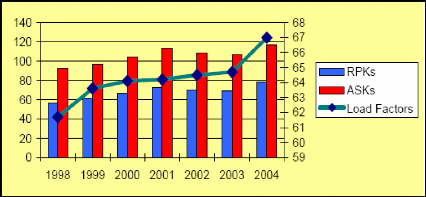
Source: AFRAA, 2005
Load factors, RPK and ASK are improving. But the overall
industry's health remains critical in Africa. Load factors may look remarkably
high, but they highlight the airlines' dilemma in the African operating
climate. The problem is that break even load factors remain higher.
Financial Performance
A sample of 8 airlines serving ASECNA region, comprising South
African Airways, Royal Air Maroc, Ethiopian Airlines, Kenya Airways, Air
Mauritius, Bellview airways, and Tunisair, made a net profit of over $200
million in 2005 (AFRAA, 2005, p.4). These are encouraging and remarkable
results in a world where airlines made huge losses in the recent past But they
do not reflect the real picture of the industry's performance. Most airlines,
some very small, some bigger, are facing serious difficulties.
Excessive debts, uncoordinated operating networks,
liquidation, bankruptcy, are examples of discrepancies generally observed
(African Union, 2005). Airlines post very poor financial results. The
issue of profitability is crucial in the region: as the market
is narrow; it is difficult for local airlines to raise the necessary investment
required by the standards of modern airlines. These airlines often
operate the same routes. That competition leads to a price war resulting merely
in weakening the economic health of these companies which have difficulties in
covering their operating costs. Air Afrique6 best
represents the airline industry's situation in the area. Air Afrique
officially lost 194 million dollars between 1984 and 1996. It almost
never made significant profit. In 2002, after years of financial crisis, the 11
states that owned the pan-African airline decided to file for bankruptcy. The
Bankruptcy came after the failure of a restructuring plan brokered by the World
Bank.
The Yaoundé treaty countries have revised their
national carriers by designating them as the flag carriers. But they are left
under the control of private interests, like Air Ivoire, Air Senegal
International, Toumaï Air Chad... etc. Cameroon Airlines and Air Gabon,
once the two leading carriers in the region, are now being liquidated or
privatized.
High Fuel prices
Fuel price is constantly rising. Fuel represents on average 25
per of operating costs. One
barrel costs on average 70$ world wide and up to
90$ in Africa (2005). The trend is
6 Air Afrique was established in 1961 to provide
passenger and cargo service within the 12 West African Nations of Benin,
Burkina Faso, Central African Republic, Cote d'Ivoire, Congo, Mali, Mauritania,
Niger, Senegal, Chad, Togo & Guinea Bissau.
expected to last. These sky-rocketing fuel prices are devastating
the industry. As airlines are struggling to improve their bottom lines, fuel
efficiency is critical.
Figure 2.9: Trend in Aviation fuel cost
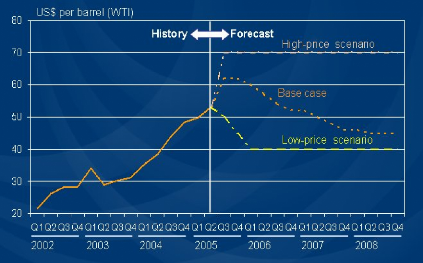
Source: Airbus, 2005
Yields and Unit Costs
Figure 2.10: Yields and Unit costs in Key
markets
14,0

|
12,0
|
|
|
|
|
|
|
|
|
|
|
|
|
|
|
|
|
10,0
|
|
|
|
|
|
|
|
|
|
|
|
|
|
|
|
8,0
|
|
|
|
|
|
|
|
|
|
|
|
|
|
|
6,0
|
|
|
|
|
|
|
|
|
|
|
|
|
|
|
|
|
|
|
|
|
|
|
|
|
|
|
|
|
4,0
|
|
|
|
|
|
|
|
|
|
|
|
|
|
|
|
|
|
|
|
|
|
|
|
|
|
|
|
2,0
|
|
|
|
|
|
|
|
|
|
|
|
|
|
|
|
|
|
|
|
|
|
|
|
|
|
|
|
|
|
|
|
|
|
|
|
|
|
|
|
|
|
0,0
|
|
|
|
|
|
|
|
|
|
|
|
|
|
|
|
|
|
|
|
|
|
|
|
|
|
|
|
|
|
|
|
|
|
|
|
|
|
|
|
|
|
|
|
|
|
|
|
|
|
|
|
|
|
|
Europe Southern Europe Western Within Europe North Atlantic
Africa Africa
Yield Unit Cost Yield Cost Margin

Source: Airbus, 2005
Yields are declining and the margins remain low. The Southern
Africa - Europe market has the lowest unit cost but also the lowest yields, and
the lowest margins. Europe - Western Africa is a healthy market for efficient
airlines, mainly European, with relatively high yields. Yields are also low in
the domestic market. The industry is not expecting a significant improvement of
yield.
Most African airlines are inefficient. This results into high
unit costs as the figure below shows it. These airlines possess old fleets
which are highly oil-consuming. High unit costs reflect low aircraft
utilization rates, high maintenance, rental and insurance costs. High air
navigation and airport unit costs reflect their old avionics, and their low
aircraft utilization.
Figure 2.11: African Airlines 7 Operating
costs (Unit cost $ per tonne per Km)
0,5 0,4 0,3 0,2 0,1
0
0,6

Fuel & Oil Flight Equipment Airport and Navigation
Charges
Avg inefficient Airline Avg Efficient Airline Avg Efficient
Worldwide

Source: Airbus, 2005
7 Flight Equipment comprises maintenance, insurance,
and rental. The others operating expenses are not mentioned here. But it's
interesting to note that administration unit costs for non efficient airlines
are extremely high, almost twenty times higher than an efficient airline' unit
costs.
| 


